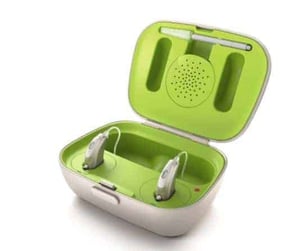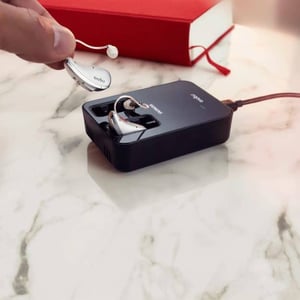Time to Read: 4 minutes
 Rechargeable batteries have absolutely revolutionised hearing aids. No more running out of power at inconvenient times, no more being without your ‘ears’ because you’ve run out of batteries.
Rechargeable batteries have absolutely revolutionised hearing aids. No more running out of power at inconvenient times, no more being without your ‘ears’ because you’ve run out of batteries.
But how much thought have you given to these powerful little marvels?
Today, we’re going to take a look at the history of batteries and the benefits of rechargeable hearing aids.
Did you know that the first rechargeable battery dates back to the Victorian era? The lead-acid battery - the type we know in most motor vehicles was invented in 1857 but batteries date much earlier than that.
Claimed to be the first battery is the "Baghdad Battery" which is dated to 250BC. Its use is still shrouded in mystery with speculation ranging from electroplating precious metals to some long forgotten religious ritual.
The lithium-ion battery is a much more recent invention and it powers everything from our mobile phones, laptop computers, electric cars and more. Even so, this innovation is nearly 50 years old.
 The concept for a lithium-ion battery was first raised in 1970 but it took nearly another two decades before a safe, reliable, powerful and conveniently sized power pack could be developed for sale.
The concept for a lithium-ion battery was first raised in 1970 but it took nearly another two decades before a safe, reliable, powerful and conveniently sized power pack could be developed for sale.
British chemist M Stanley Wittingham, Texan scientist John Goodenough and Japanese scientist Akira Yoshino were jointly recognised with a 2019 Nobel Prize from Chemistry for their work on this amazing technological advance.
The first rechargeable hearing aids first came out in the market in 2016 and since then they have been adopted by every hearing aid manufacturer as an option to the disposable zinc-air batteries.
Pros and cons of Rechargeable Hearing aids
Pros
No more on-going costs
With rechargeable hearing aids you don’t have the ongoing expense of purchasing disposable batteries.
One charge lasts all day
Place your hearing aids in their charging station before you go to bed at night and wake up to have them fully charged and last you throughout the day. Lithium-ion batteries also cope better with streaming than disposable batteries.
Fully charged batteries can last the entire day, which is 19 hours of battery life, including up to five hours of streaming.
Better for the environment
If you are concerned about single-use, disposable items, then rechargeable hearing aids are definitely your best option.
Easier to handle
It can be a right royal pain to take out spent batteries for new ones - especially if dexterity is an issue. Rechargeable hearing aids need only a once a day charge. Some manufacturers have special cases to set your hearing aids in to charge, others use induction charging to make it even more convenient.
Safer for kids and pets
Because Lithium-ion batteries are built into the hearing aid, it eliminates the risk of batteries lying about which pose a risk of serious injury and death for children and pets who may swallow it.
Cons
Rechargeable hearing aids may not be the right solution for you under particular circumstances, so do speak to your clinician.
Lifestyle reasons
We have a client who works on an off-shore gas rig and so his hearing aids have to work under very demanding conditions. Given his living circumstances, he doesn’t always get the time to give his aids the uninterrupted time needed to charge, so it is more convenient for him to keep batteries on him at all times while he’s working.
Forgetting to put the aids on charge/putting them on the charger incorrectly
There is nothing more inconvenient than having your hearing aids run out of power in the middle of the day.
It is important to ensure that your rechargeable hearing aids are in their docking station correctly to charge. Some clients who have had trouble with their rechargeable hearing aids needed additional instruction on how to ensure their aids were locked in for charging.
More reading:
- Sounds from the Past - https://www.valuehearing.com.au/news/sounds-from-the-past-the-history-of-the-hearing-aid
- The History of the Hearing Aid - https://www.valuehearing.com.au/news/history-of-hearing-aids
- World First: Rechargeable in-the-ear hearing aid: Starkey ITC-R -https://www.valuehearing.com.au/news/world-1st-rechargeable-in-the-ear-hearing-aid-starkey-itc-r

